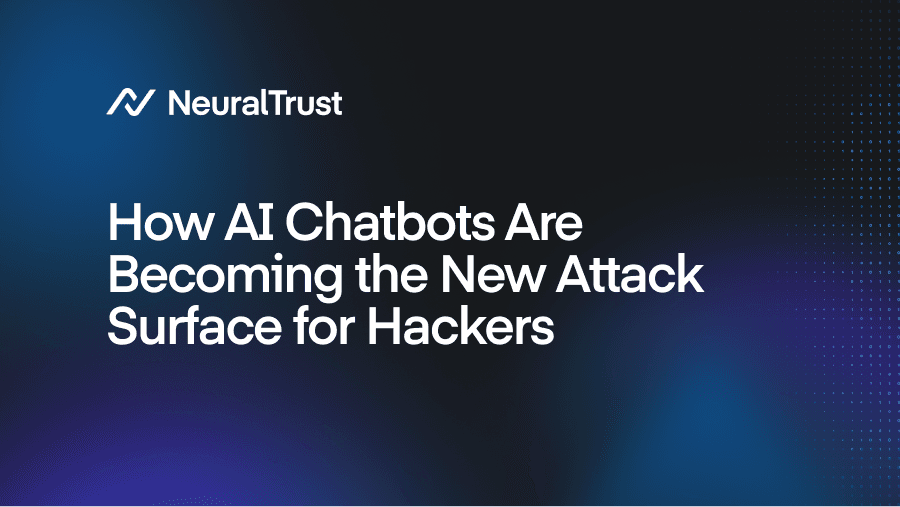In the age of hyper-automation and instant customer engagement, AI chatbots have emerged as a cornerstone of modern digital strategy.
From e-commerce to SaaS platforms, they are reshaping how companies interact with users efficiently, affordably, and at scale.
But as businesses embrace AI-driven interfaces, they are also unknowingly expanding their attack surface.
The tools designed to streamline customer experience are now being probed, manipulated, and exploited in increasingly sophisticated ways.
In this article, we'll explore how AI chatbots are becoming the new frontier for cyberattacks, what business leaders need to understand about this evolving threat landscape, and how to mitigate the associated risks.
The Allure of Chatbots for Attackers
AI chatbots are designed to simulate human conversation and assist users across a variety of functions, from customer support to onboarding.
Their integration into critical systems and access to sensitive data make them attractive targets for threat actors. Unlike traditional web forms or static interfaces, chatbots often operate on flexible logic, using natural language models that can be manipulated with the right input.
The rise of prompt hacks, which are attacks that manipulate the inputs of a chatbot to alter its behavior, is one example. Hackers use cleverly crafted prompts to bypass restrictions, extract confidential information, or redirect users to malicious links. Known as prompt injection attacks, these tactics are simple in concept but can lead to severe consequences.
What Makes AI Chatbots Vulnerable?
Several factors contribute to the vulnerability of AI chatbots:
-
Lack of Input Validation: Many chatbots fail to adequately sanitize or verify user input, making them susceptible to prompt injections or logic manipulation.
-
Overreliance on Generative AI: Generative models like GPT can hallucinate or respond to adversarial prompts if not properly grounded with guardrails.
-
Broad Access to Internal Systems: Chatbots integrated with CRMs, support ticketing systems, or knowledge bases often have read/write access to business-critical data.
-
Rapid Deployment, Minimal Testing: In the rush to automate, security testing is often an afterthought. This creates blind spots in production environments.
Real-World Exploits and Threat Examples
Recent research and security analyses have outlined just how real, and varied, the threat landscape around AI chatbots is becoming:
-
Security experts have warned that chatbots deployed in financial services could be vulnerable to prompt injection attacks. In these scenarios, attackers might craft specific inputs designed to bypass the model’s content filters, potentially tricking the AI into revealing internal policies or sensitive operational details. While no public incident has confirmed such a breach, the risk is credible enough to prompt concerns around the use of LLMs in high-stakes environments like banking and insurance.
-
The rise of AI-powered phishing is another growing concern. By mimicking the natural tone of human conversation, LLMs can be exploited to generate personalized, convincing spear-phishing messages at scale, making traditional phishing defenses less effective.
-
Security companies have shown how indirect command execution could occur in systems where chatbots are tightly integrated with backend services or external APIs. Through a method known as prompt injection, attackers can craft inputs that manipulate the chatbot into generating commands or requests that trigger unintended actions, such as accessing internal systems or initiating transactions, particularly in setups with weak input validation.
-
And while not a direct result of prompt injection, recent incidents like the WotNot data exposure show how AI platforms can become high-value attack surfaces. In that case, a misconfigured storage bucket exposed over 346,000 sensitive files, including financial records and ID documents, highlighting the broader risks of insufficient security practices in AI-backed infrastructure.
These scenarios might not yet be widespread in the wild, but the technical groundwork has been laid, and attackers are paying attention.
Why Business Leaders Should Care
AI chatbots are no longer experimental tools, they’re embedded into customer journeys, support workflows, onboarding systems, and even sales pipelines. That means the risks associated with them are not theoretical, they’re business risks.
When a chatbot fails, it’s not just a tech issue. It’s a trust issue. A single exploit, whether it leads to a data leak, phishing attack, or compliance violation, can erode customer confidence, damage brand reputation, and trigger costly legal consequences.
Even more critically, these risks often go unnoticed until it’s too late. Traditional security audits may not account for the dynamic nature of LLMs or the novel attack vectors associated with natural language inputs. And in many cases, chatbot implementations fall outside the direct purview of security teams, developed quickly by product or CX teams under pressure to automate and scale.
Here's why this should be on every business leader’s radar:
-
Regulatory Exposure: Mishandling sensitive data, even indirectly through an AI system, can result in violations of GDPR, HIPAA, or sector-specific compliance frameworks.
-
Brand Vulnerability: Chatbots act as the public face of your company. If manipulated, they can deliver offensive, misleading, or malicious responses, turning helpful tools into reputation risks.
-
Operational Disruption: A compromised chatbot connected to internal systems can trigger downstream actions, from modifying databases to submitting fraudulent support tickets or refund requests.
-
Compromised Customer or Employee Data: Chatbots with access to CRMs, HR systems, or support platforms may inadvertently expose personal or confidential information during a prompt injection or data leakage incident, putting both customer and employee privacy at risk.
-
Financial Risk: Attacks like AI-powered phishing or API exploitation through chatbot integrations can have a direct monetary impact, especially in fintech, e-commerce, and SaaS environments.
-
Loss of Competitive Advantage: If attackers extract proprietary information, such as product roadmaps, pricing models, or internal strategies, through poorly secured AI systems, the business could lose its edge in the market.
For organizations betting on AI to drive efficiency and innovation, ignoring chatbot security is like installing a smart lock on your front door and leaving the back window wide open.
Business leaders don’t need to become AI experts, but they do need to understand the security posture of the tools they deploy, ask the right questions, and ensure that cross-functional teams, security, engineering, product, and legal, are aligned on safe AI adoption.
The Rise of "Hack Prompt" Culture
Among cybersecurity communities and forums, a new discipline is forming around crafting attack prompts. The term "hack prompt" now refers to structured inputs designed to manipulate large language models (LLMs) or extract unintended outputs.
These prompts are often shared in underground communities and even marketed as plug-and-play exploits for specific platforms, effectively lowering the barrier to entry for non-technical attackers.
This emerging culture has been observed in public forums like Reddit’s r/LangChain, where users openly discuss prompt injection strategies and their implications.
Additionally, cybersecurity firms have flagged the spread of “jailbreak prompts”, inputs crafted to override an AI’s built-in safety restrictions and generate prohibited responses.
These are often documented or even sold in lesser-known forums, creating a gray market for LLM exploits.
While not inherently malicious, the rapid sharing and refinement of these techniques raise concerns about how quickly threat actors, especially low-skill ones, can leverage them for social engineering, phishing, or misinformation campaigns.
Mitigation Strategies for Enterprises
Securing AI chatbots is no longer optional, it’s a strategic imperative. To reduce risk, business leaders must go beyond reactive patching and adopt a proactive, layered defense approach that anticipates how attackers may exploit LLM-based systems.
At NeuralTrust, we help enterprises design and deploy secure-by-default AI solutions. Here’s what that looks like in practice:
1. Deploy AI Gateways
AI gateways act as intelligent control layers between users and your language models. They enable you to enforce guardrails, inject context-aware safety measures, and monitor for unsafe queries before prompts ever reach the model. NeuralTrust’s secure AI pipelines are built with this architecture in mind, enabling you to scale without sacrificing control.
2. Implement Prompt Filtering and Sanitization
Not all user input is safe by default. Enterprises should apply strict validation rules to detect prompt injection patterns, adversarial phrasing, and unauthorized instructions. NeuralTrust uses advanced natural language filtering to flag and neutralize potentially harmful inputs in real time.
3. Enforce Least Privilege Architecture
Limit what your chatbot can see and do. Avoid full API access to internal systems unless it’s absolutely necessary. With NeuralTrust’s role-based access controls and fine-grained permissions, you can ensure your chatbot has only the minimal access required to perform its task, nothing more.
4. Red Teaming and Adversarial Testing
Proactively test your chatbot under fire. Simulate attacks using real-world “hack prompts” to uncover hidden vulnerabilities. NeuralTrust offers AI-specific red teaming services to stress-test your chatbot’s behavior under adversarial conditions—before attackers get the chance.
5. Monitor and Log All Interactions
Implement full visibility into how your chatbot behaves across different contexts. With NeuralTrust’s continuous monitoring and anomaly detection, you can identify deviations, flag suspicious behavior, and respond in real time.
Looking Ahead: Trust and Safety as a Business Imperative
The use of AI chatbots will continue to grow, driven by their immense value in scaling operations and enhancing user experiences. But this growth must be matched by a commitment to AI security and trustworthiness.
Forward-thinking organizations are beginning to view security not as a cost, but as a strategic asset. Securing your AI interfaces isn’t just about preventing breaches, it’s about protecting your users, your brand, and your bottom line.
At NeuralTrust, we help businesses design AI systems that are not only powerful but resilient. The future belongs to those who build AI with trust at the core.
The bottom line?
AI can be transformative but only when it’s secure. At NeuralTrust, we help forward-thinking teams build resilient, trustworthy AI systems from the ground up. If you're deploying chatbots in sensitive or high-risk environments, let's talk.




